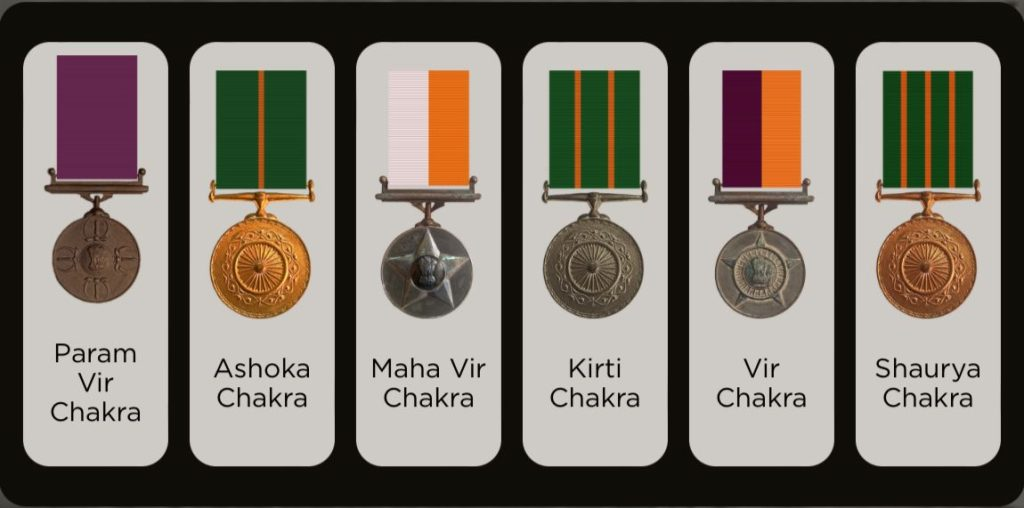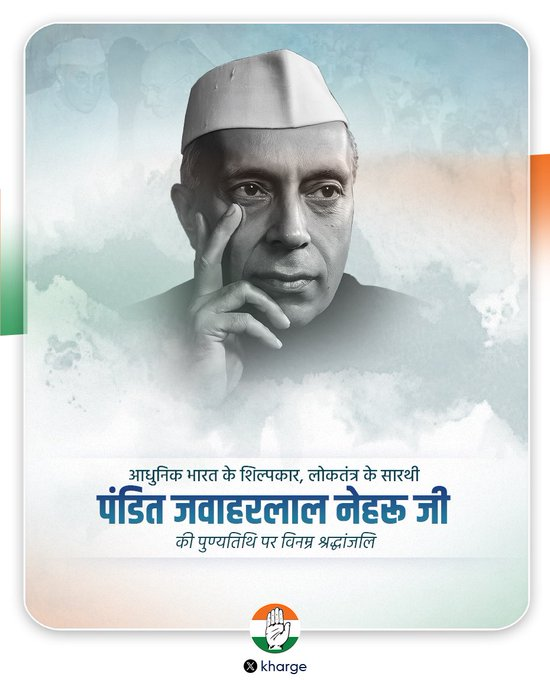Uttar Pradesh Switch to Hindi
Gallantry Awards 2025
Why in News?
The President of India conferred Gallantry Awards, including 6 Kirti Chakras (4 posthumously) and 33 Shaurya Chakras (7 posthumously), to personnel from the Armed Forces, Central Armed Police Forces, and State/UT Police, which were announced on the eve of the 76th Republic Day 2025.
Key Points
Gallantry Awards
- About: They are given to the personnel for displaying raw courage, unparalleled bravery and total disregard to personal safety in the line of duty.
- These gallantry awards are announced twice a year, first on the occasion of Republic Day and then on the occasion of Independence Day.
- Types:
- Gallantry Award in the Face of the Enemy:
- Param Vir Chakra (PVC): It shall have embossed on the obverse four replicas of "Indra's Vajra" with the State Emblem embossed in the centre.
- It is awarded for the most conspicuous bravery or some daring or pre-eminent act of valour or self-sacrifice, in the presence of the enemy.
- Mahavir Chakra (MVC): It shall have embossed on the obverse a five-pointed heraldic star with the points of the star just touching the rim. The star shall have in the centre a domed gilded State Emblem.
- It is awarded for acts of gallantry in the presence of the enemy.
- Vir Chakra: The star will feature a Chakra at its centre, with a domed centerpiece inside the Chakra bearing the gilded State Emblem.
- It is awarded for acts of gallantry in the presence of the enemy on land, at sea or in the air. The decoration may be awarded posthumously.
- Param Vir Chakra (PVC): It shall have embossed on the obverse four replicas of "Indra's Vajra" with the State Emblem embossed in the centre.
- Gallantry Award Other than in the Face of Enemy:
- Medals: It includes Ashok Chakra, Kirti Chakra, and Shaurya Chakra, on which the obverse of the medal shall be embossed with a replica of the respective chakra in the centre, surrounded by a lotus wreath.
- Along the rim, on the inner side, shall be a pattern of lotus leaves, flowers, and buds.
- On its reverse shall be embossed the respective words, both in Hindi and English, the two versions being separated by two lotus flowers.
- Medals: It includes Ashok Chakra, Kirti Chakra, and Shaurya Chakra, on which the obverse of the medal shall be embossed with a replica of the respective chakra in the centre, surrounded by a lotus wreath.
- Gallantry Award in the Face of the Enemy:
- Order of precedence of the Award:
- Param Vir Chakra
- Ashoka Chakra
- Mahavir Chakra
- Kirti Chakra
- Vir Chakra
- Shaurya Chakra
- Eligibility:
- For Param Vir Chakra, the Maha Vir Chakra and the Vir Chakra: All ranks of the Naval, Military, Air, Reserve, and Territorial Forces, including medical and nursing staff, and civilians serving under their direction.
- For Ashoka Chakra, Kirti Chakra & Shaurya Chakra: All ranks of the Armed Forces, Reserve and Territorial Forces, Nursing Services, Police, Central Para-Military Forces, Railway Protection Force, and civilian citizens.
Uttar Pradesh Switch to Hindi
Death Anniversary of Pandit Jawaharlal Nehru
Why in News?
The death anniversary of India’s first Prime Minister, Pandit Jawaharlal Nehru, was observed on 27th May 2025.
- He is remembered as the Architect of Modern India.
Key Points
Jawaharlal Nehru (1889-1964)
- Early Life: He was born on 14th November 1889, into a Kashmiri Brahmin family in Allahabad (now Prayagraj).
- Fondly called ‘Chacha Nehru’ for his deep affection for children, his birthday is celebrated as Children’s Day every year in India.
- He attended his first Congress session in 1912 at Bankipore (Patna) as a delegate and joined Annie Besant’s Home Rule League in 1916, becoming its Allahabad Secretary in 1919.
- Contribution in Freedom Struggle: He was elected Congress President at the 1929 Lahore session, passing the historic Purna Swaraj resolution for complete independence, and later presided over the 1936 Lucknow and 1937 Faizpur sessions, promoting socialism.
- He drafted the Fundamental Rights and Economic Policy (1929-31), adopted at the 1931 Karachi Session under Sardar Patel, and advocated legal defence for Indian National Army (INA) soldiers.
- He led the Interim Government in 1946.
- Post-Independence: In 1953, he formed the States Reorganisation Commission, promoted industrialisation through Five-Year Plans, and led the Non-Alignment Movement.
- Awards: He was awarded the Bharat Ratna (1955) and World Peace Council Prize (posthumously, 1970).
- Literary Contributions: The Discovery of India, An Autobiography, Glimpses of World History and Letters from a Father to His Daughter.
Haryana Switch to Hindi
Indian Grey Wolf
Why in News?
The Indian grey wolf (Canis lupus pallipes) was recently sighted near the Yamuna floodplains in Delhi, marking the first recorded sighting in the city since the 1940s.
- The wolf was spotted in Palla, a village located on the banks of the Yamuna River, at the tri-junction of Delhi, Haryana, and Uttar Pradesh.
Key Points
Indian Grey Wolf
- About: The Indian Grey Wolf is a subspecies of the Grey Wolf native to the Indian subcontinent and Southwest Asia.
- It is nocturnal and an apex predator that hunts in small packs and is less vocal compared to other wolf subspecies.
- Appearance: A carnivore of the Canidae family, the Indian Grey Wolf has a length of 100–130 cm in males and 87–117 cm in females.
- It is intermediate in size between the Tibetan and Arabian wolves and lacks a thick winter coat, adapting to warmer climates.
- Habitat & Distribution: From Israel in the west to the Indian subcontinent in the east, inhabiting scrublands, grasslands, pastoral agro-ecosystems and semi-arid agro-ecosystems in warmer regions.
- They are found in the states of Maharashtra, Gujarat, Madhya Pradesh, Rajasthan, Haryana, Uttar Pradesh, and others.
- Conservation Status:
- CITES: Appendix I.
- Wildlife Protection Act, 1972: Schedule I.
Uttar Pradesh Switch to Hindi
Semiconductor Unit in Uttar Pradesh
Why in News?
The Union Cabinet has approved a ₹3,700 crore display driver chip manufacturing unit at Jewar, Uttar Pradesh.
- This project is the sixth semiconductor manufacturing unit sanctioned under the first phase of the India Semiconductor Mission (ISM).
Key Points
- Project Details:
- The unit will be a joint venture between Indian firm HCL and Taiwanese electronics manufacturing giant Foxconn.
- Commercial production at the Jewar plant is expected to begin by 2027, necessitating rapid construction and development.
- Chips manufactured will be used in laptops, PCs, smartphones, and automobiles.
- The unit will be a joint venture between Indian firm HCL and Taiwanese electronics manufacturing giant Foxconn.
- Strategic Importance:
- This is the first semiconductor manufacturing plant in Uttar Pradesh, located in the rapidly developing industrial area of Jewar.
- The Uttar Pradesh government has launched its own UP Semiconductor Policy - 2024.
- This ambitious policy is designed to boost local semiconductor manufacturing, enhancing India’s strategic independence in critical technology sectors.
- The plant is expected to fill a critical gap in India’s display and electronics value chain.
- Once operational, it is anticipated that a display panel manufacturing plant will also be established in India, potentially meeting about 40% of India’s display capacity.
- This is the first semiconductor manufacturing plant in Uttar Pradesh, located in the rapidly developing industrial area of Jewar.
- Significance of the Project:
- Boost to Make in India & Electronics Manufacturing: The project aligns with India’s push towards self-reliance in semiconductor manufacturing, a key component for technological sovereignty and economic growth.
- Employment & Industrial Development: The unit will spur industrial activity in Uttar Pradesh, generating employment and attracting ancillary industries.
- Reducing Import Dependence: Enhancing domestic chip production reduces reliance on imports and strengthens India’s electronics supply chain resilience.
India Semiconductor Mission (ISM)
- The ISM was launched in 2021 with a total financial outlay of Rs 76,000 crore under the aegis of the Ministry of Electronics and IT (MeitY).
- It is part of the comprehensive program for the development of sustainable semiconductor and display ecosystems in the country.
- The programme aims to provide financial support to companies investing in semiconductors, display manufacturing and design ecosystem.
- Envisioned to be led by global experts in the Semiconductor and Display industry, ISM will serve as the nodal agency for efficient, coherent and smooth implementation of the schemes.
Madhya Pradesh Switch to Hindi
MP High Court Upholds Withdrawal of Financial Powers of Sarpanch
Why in News?
The Madhya Pradesh High Court recently upheld the decision of the Chief Executive Officer (CEO), District Panchayat, to withdraw the financial powers of Sarpanch of Gram Panchayat on charges of corruption.
- The withdrawal followed the registration of a Lokayukta case against the sarpanch for demanding a bribe.
Key Points
- Arguments Regarding the Case:
- The sarpanch challenged the order, contending that the CEO acted beyond jurisdiction since no specific provision allows withdrawal of financial powers merely upon registration of a criminal case.
- High Court Verdict:
- HC referred to the Madhya Pradesh Panchayat (Powers & Works of CEO) Rules, 1985.
- It observed that the CEO has supervisory and controlling powers over Panchayats, including ensuring proper use of allocated funds.
- Withdrawing financial powers of the Panchayat representative on corruption charges falls within the CEO’s jurisdiction.
- Consequently, the HC dismissed the petition filed by the sarpanch.
- Legal and Governance Implications:
- Role of CEO in Panchayat Administration: The ruling clarifies the extent of powers of the CEO, District Panchayat, highlighting the supervisory role over Panchayat activities and safeguarding public funds.
- Checks Against Corruption: The decision reinforces administrative checks against corruption at the grassroots level by allowing timely intervention even before final adjudication in criminal cases.
- Balancing Due Process and Administrative Action: While the criminal case is pending, administrative authorities are empowered to take preventive measures to avoid misuse of funds, reflecting a balance between legal due process and governance accountability.
Governance of Panchayti Raj Institutions (PRIs)
- State Subject: Local governance falls under the jurisdiction of state governments, with PRIs operating as per respective State Panchayati Raj Acts.
- Constitutional Framework:
- 73rd Constitutional Amendment Act (1992) established a three-tiered Panchayat system and mandated 1/3rd reservation for women, later increased to 50% in 21 states and 2 UTs.
- Article 243D provides for reservation for Scheduled Castes, Scheduled Tribes, and Backward Classes in PRIs.
- Article 40 of the Constitution, a Directive Principle of State Policy, mandates the State to establish village panchayats and grant them the necessary powers and authority to function as self-governing units.
- The Panchayats Extension to Scheduled Areas (PESA) Act, 1996, grants Gram Sabhas in Scheduled Areas special powers to manage natural resources and protect tribal culture and livelihoods.


.png)








.png)


.jpg)



 PCS Parikshan
PCS Parikshan





